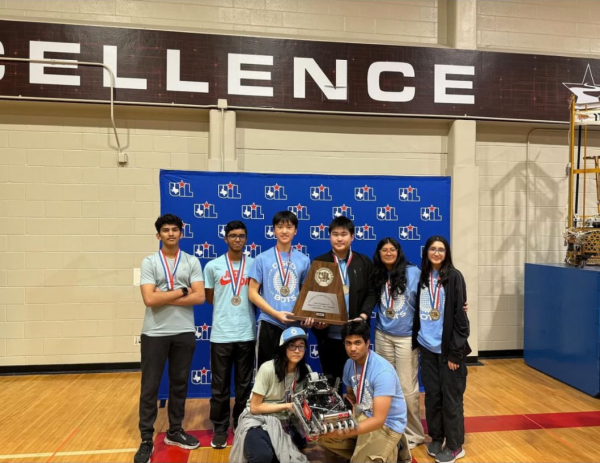Is There Meat to the Argument for Veganism? A Vegan and Non-Vegan Decide
Hannah Holliday’s bowl of ramen, an example of the diversity of vegan food.
Food. We Houstonians are known for offering a diverse culinary landscape of it that’s predominantly carnivorous. After all, we are a nook within the larger Lone Star State of bluebonnets, beer, and barbecue. Carnegie Vanguard High School seems to be no different in its preference of food palette, serving and selling food like nachos, chicken sandwiches and wings, and pizza as main courses. However, for a select minority of people, veganism has become a gateway to long-lasting good health and increase school performance.
Veganism is absolutely booming within the context of a more eco-conscious, health-conscious, body-conscious society. Many people across our voraciously carnivorous country, including celebrities like Benedict Cumberbatch, Sia, Joaquin Phoenix, and Radiohead’s Thom Yorke are vegan. Vegans, by definition, are people who neither eat nor utilize animal products and by-products. As of 2017, they make up 1-2% of America’s population. People become vegans for numerous reasons, including but not limited to health, religion, and concern for the environment or animals. One such person is a Carnegie Vanguard senior named Hannah Holliday.
Holliday has been vegan for over 2 years and advocates for mass education about this holistically beneficial diet. Her overall feeling of vitality has shot to great heights, creating a sense of balance that carries her throughout the school day. She specifically praises veganism for its potentially advantageous effects on the hustling, bustling Carnegie Vanguard student.
“I’m finding that I have a lot more energy and I generally feel better about my body,” Holliday comments on the observation of her own health. With significantly higher energy levels, far fewer dips in energy (especially after lunch), and improved concentration, Holliday reports that her performance at school has “increased since becoming vegan”.
“When you have a diet that largely consists of whole fruits and vegetables you become more in tune.” This is, in fact, true for everyone regardless of diet; a consistent intake of fruits and vegetables lowers the risk of heart disease, increase fiber intake, and benefits the body in more systems than one. She intends to sustaining her plant-based diet as a way of feeling generally cleaner and healthier.
However, for sophomore Joshua De La Rosa, veganism is something that simply doesn’t appeal to him. Joshua has been an avid meat-eater all his life and believes that changing his current eating habits would require too much effort as veganism is something you need to be dedicated to in order to correctly execute the lifestyle without enabling a loss of nutrients.
“I would not personally [convert to a vegan lifestyle] just because I feel like it’ll take too much effort and for me to just change my diet right now, it’s not exactly convenient. If I were to change to a vegan diet, then I would need to actually want to do it and be motivated in order to put in the effort to continue it,” De La Rosa said.
The weekly cost of being vegan also plays a role in people’s decisions to convert to the lifestyle. Although staple foods such as rice and beans are fairly cheap when compared to meat and dairy products, finding non-staple foods and snacks like chips and ice cream is more difficult and expensive. A normal bag of Lay’s potato chips usually costs around $1-2. In comparison, vegan chips can run someone $6. The same trend occurs with ice cream, as a pint of normal ice cream costs a little over $3 while vegan ice cream costs $5-6. During the transition to veganism, these price differences may not seem like a lot. However, in the long run, the costs start to add up. It seems that in order to snack as a vegan, one must remove themselves from the norm of packaged foods and transition to the whole, clean snacks that cost far less. A low-income vegan might have to trade in their Lenny & Larry’s packaged vegan cookies for, say, a simple snack like nuts in bulk.
“Because vegan foods are relatively more expensive, I know that I would be unable to buy vegan products regularly. Also, I take the bus to school and my stop gets picked up early in the morning so I have to sleep and wake up early. For my family, it’s more efficient if I eat school lunch rather than having to wake up earlier than I already do or stay up later to pack lunch,” De La Rosa said. Even though Carnegie Vanguard offers salads, students can only get them on Tuesdays and Thursdays, so it would be extremely hard for Joshua to become vegan in terms of the bigger picture.
Despite popular preconceived misconceptions, just about any food nowadays can be vegan. Ramen, pho, barbecue, curry, burgers–all this and everything in between can be completely free of animal products. Avid vegans like Holliday encourage the Carnegie Vanguard population to challenge their stasis and learn more about the actual diversity of vegan food that exists because upon gauging plant-based and non-plant-based students alike, the greatest stigma surrounding veganism is the following: “What can you actually eat while being vegan?” Within a city like Houston, that’s on its toes about food and food trends, the answer is simple -everything.
For over a decade, veganism has become more popular and prominent in the Houston area as veganism becomes more popular among people. The veganism debate has been at a standstill for over a decade; vegans are pleasantly surprised to find that the diet isn’t as daunting as it seems if they are financially equipped for the lifestyle–non-vegans must combat the pressures of daily inconvenience and cost in order to uproot themselves completely for the impetus of a cleaner conscience.
Your donation will support the student journalists of Carnegie Vanguard High School. Your contribution will allow us to cover our annual website hosting costs and fund field trips, competition fees, and equipment. We appreciate your support!

I am a senior who LOVES dance parties. And peace and quiet.
Instagram: @amourannie












